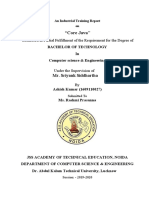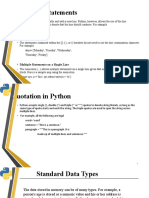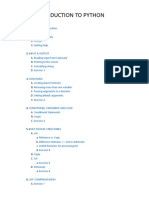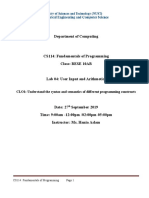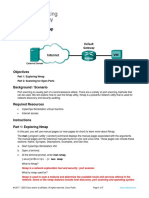Lab 3 - Introduction of Python and IDLE
Uploaded by
Waseem AbbasLab 3 - Introduction of Python and IDLE
Uploaded by
Waseem AbbasDepartment of Computing
CS114: Fundamentals of Programming
Class: BESE 10AB
Lab 03: Introduction of Python and IDLE (Integrated
Development Environment)
CLO1: Understand the syntax and semantics of different
programming constructs
Date: 20th September 2019
Time: 9:00am -12:00pm /02:00pm-05:00pm
Instructor: Ms. Hania Aslam
CS114: Fundamentals of Programming BESE-10(AB) Page 1
Lab 3: Introduction of Python and IDLE
Introduction
This lab is designed to develop basic understanding with python and its
development environment IDLE.
Objectives
The objective of this exercise is to become familiar with the Python IDE for
version 3.x while introducing basic mathematical operations, variable types, and
printing options.
Tools/Software Requirement
Python IDLE
Description
Follow the lab manual step by step. As you proceed, you will be asked to add
screenshots/snaps of your results inside the provided output windows within this
manual for grading purposes.
Introduction to Python:
Python is a widely used high-level programming language used for general-
purpose programming, created by Dutch programmer Guido van Rossum and first
released in 1991. Its syntax allows programmers to express concepts in fewer
lines of code than possible in languages such as C++ or Java.
Virtually all modern programming languages make use of an IDE, or
Integrated Development Environment, which allows the creation, editing, testing,
and saving of programs and modules. In Python, the IDE is called IDLE (like
many items in the language, this is a reference to the British comedy group Monty
Python, and in this case, one of its members, Eric Idle).
Before opening IDLE, it is worth recalling that there are three basic types of
simple variables in Python: integers (whole numbers, commonly used as an
index), floats (that is, numbers with a decimal point, AKA real numbers), and
strings (collections of alphanumeric characters such as names, sentences, or
numbers that are not manipulated mathematically such as a part number or zip
code). A legal variable name must start with a letter. It is then optionally followed
CS114: Fundamentals of Programming BESE-10(AB) Page 2
by some collection of letters, numerals and the underscore. It cannot contain any
other characters or spaces, and cannot be a reserved word (i.e., a word with a
special meaning in the language such as a command or operator). In Python,
variables may be created by simply declaring them and assigning a value to them.
Examples include:
a=2.3
name=“Joe”
It is best to think of the equal sign as “gets”. That is, think of the first example as
“the variable a gets the floating point value 2.3” and the second as “the variable
name gets the string Joe”. An assignment command such as these literally
reserves space in the computer’s memory for the variable and tags it with the
variable name. Then, it stores the appropriate value at that location for future use.
Lab Work :
Open IDLE by selecting Python from the Start menu and then choosing the option
to open IDLE (Python GUI). Do NOT open the command line. Alternately, open
the IDLE (Python GUI) icon on the desktop. A simple text window known as the
Python shell will open. It should have a white background with a text message at
the top and immediately below that, a cursor prompt >>>
The shell serves two functions. First, it can serve as a sort of scratch pad to try
snippets of code (shown in the steps below). Second, it can serve as the text
output window for larger programs. Do not try to use this window for the creation
of complete programs that you wish to save. We shall use this window to create a
few variables and perform some basic manipulations on them.
Type the following and then hit the Enter key:
a=5
The >>> should reappear. This command defines a variable called a and copies
the integer value 5 into it. In similar manner, type in the following commands:
b=13 x=5.0 y=13.0 m=“Mary” n=“Nancy” It is very important that the “.0”
portions be included. This is how integers and floats are distinguished: floats
always have a decimal point, integers don’t. Also, it is possible to define the
CS114: Fundamentals of Programming BESE-10(AB) Page 3
strings using the apostrophe ‘ in addition to the double quote ”. This can be handy
if you need to have a string that includes a quote or apostrophe within it; merely
define the string with the other character.
In any case, the computer’s memory now looks something like this:
Variable Name Value
a 5
b 13
x 5.0
y 13.0
m Marry
n Nancy
The trick now, of course, is to access these values, manipulate them, and see the
results. An important command for this process makes use of the print function.
The print function will print whatever is passed into it, either variables or
expressions, on to the output window. Note that like all built-in commands and
functions in Python, this function is all lower case. Capitalizing it will generate an
error. Also, note that commands will be color coded as orange-red.
Next, at the prompt, type the following:
print ("hello world")
The output should be hello world
Now type:
print( a )
The output should be the integer 5
[1 Mark]
Output of print(a)
Add snap here.
Now type:
print( a, x, m, n )
CS114: Fundamentals of Programming BESE-10(AB) Page 4
In this case, the following sequence should result:
5 5.0 Mary Nancy
[1 Mark]
Output of print(a, x, m, n)
Add snap here.
Continue with the following expression:
print( a + b )
[1 Mark]
Output of print(a+b)
Add snap here.
This results in the value 18. This line retrieves the values of a and b from
memory, adds them together, and prints the result on the output window. Neither
a nor b are altered in the process. Alternately, we could have created a brand new
variable and printed it. The result will be the same. Enter the following two lines
to verify this:
c=a+b
print( c )
[1 Mark]
Output of print(c)
Add snap here.
The only difference is that this version adds a new “slot” called c to the memory
map above. It is worth noting that once a variable is created, its value may be
recomputed over and over if desired. For example, type the following:
c = 20 + a
print( c )
[1 Mark]
CS114: Fundamentals of Programming BESE-10(AB) Page 5
Output of print(c)
Add snap here.
The result should be 25. The first line computes a new value which then
overwrites the prior value of 18.
Besides addition, the other main math operators are –(subtraction), *
(multiplication), / (division). Parentheses ( ) may be used to force the execution of
some operations before others. Parentheses have the highest precedence and are
followed by multiplication, division, addition and subtraction. That is, the
expression a=b+c*d will multiply c by d before b is added. To force the addition
first, use parentheses as:
a=(b+c)*d
Remember, think of the equal sign as “gets” as in “a gets the value computed by
the expression”. It is an assignment, not a true mathematical relation. That is, if at
some point in the future the value of b was to change, a will not automatically be
altered to reflect that change. This allows you to do the following:
c=c+1
Type this in. What do you think the result will be?
What the above statement says is, “Retrieve the current value of c, add one to it,
and store the result back in c (overwriting the original value). Print out the value
of c. You should get 26 (the prior value of 25 plus one). Continuing with the
other math operators, type:
print( y/x )
[1 Mark]
Output of print(y/x)
Add snap here.
The result should be 2.6. Now try the following:
print( b/a )
CS114: Fundamentals of Programming BESE-10(AB) Page 6
[1 Mark]
Output of print(b/a)
Add snap here.
The result is also 2.6 even though both variables are integers (an integer, of
course, can’t contain a fractional portion). In essence, Python promotes the
variables to floats in order to maintain precision, producing a floating point
answer. Now try:
print( b/x )
[1 Mark]
Output of print(b/x)
Add snap here.
In this case the answer is again 2.6. This is because in a mixed calculation
between a float and an integer, the integer is again promoted to a float in the
calculation in order to maintain the precision of the floating point variable.
Interactive Mode vs. Scripted Mode
Python can be run in one of two modes. It can either be used interactively as
explained above, via an interpreter, or it can be called from the command
line/Scripted Mode to execute a script.
To Open and Use Python in Scripted Mode
1. Open IDLE
CS114: Fundamentals of Programming BESE-10(AB) Page 7
2. Go to File >> New File
3. Enter your code
4. Save the file on your desired location
CS114: Fundamentals of Programming BESE-10(AB) Page 8
5. Either save the file by selecting Python files from Save as type
OR explicitly define the type of file by writing .py extension at the end of the
name
6. See the name of the file has been changed with the .py extension
7. Now Go to Run >> Run Module OR enter F5 on your keyboard to run the code in
Scripted Mode
CS114: Fundamentals of Programming BESE-10(AB) Page 9
8. Observe the output. It should appear as shown below:
Final Lab Tasks:
Write programs for the following problems. Make use of the best
programming practices (documentation/variable naming conventions e.t.c)
discussed in the class to gain maximum marks.
[3+1=4 marks]
1. Write a program in the scripted mode that adds three numbers (of your choice)
together. Use variables to store the values in your program and consider the
following rules.
Condition: You cannot add more than two numbers in a single line i.e.
Hint: a+b+c is not allowed
a+b is fine.
Source Code(sum.py)+ Output Snap
Add your source code here.
CS114: Fundamentals of Programming BESE-10(AB) Page 10
[3+1=4 marks]
2. Write a program convert.py that converts the temperature from Celsius to
Fahrenheit and displays the result to the screen.
Conversion Formula: (9/5) * Celsius + 32
Sample Test Value: 45 Degree Celsius
Source Code( converter.py)+ Output Snap
Add your source code here.
[3+1=4 marks]
3. Mr. Shahwaiz has provided you with the electricity bills for past three months.
The bills for the last three months have been $67, $48 and $94. Write a
program that computes average monthly electricity bill over the three month
period. Using variables write an appropriate expression to calculate the mean,
and use print( ) to display the result.
Source Code( average_electricity_bill.py)+ Output Snap
Add your source code here.
CS114: Fundamentals of Programming BESE-10(AB) Page 11
Deliverables
Compile a single Word document by filling in the solution/answer part (as directed)
along with the snapshots and source code. Name your submission file as given below and
submit this Word file on LMS before the deadline.
Name – Registration No. – Section
Grade Criteria
This lab is graded. Min marks: 0. Max marks: 20.
Activity Minimum Maximum
CS114: Fundamentals of Programming BESE-10(AB) Page 12
Documentation with clearly defined Fail Pass
understanding of the lab task and approach
print(a) 0 01
print( a, x, m, n ) 0 01
print( a + b ) 0 01
print( c ) 0 01
After adding 20, print( c ) 0 01
print( y/x ) 0 01
print( b/a ) 0 01
print( b/x ) 0 01
Lab Task 1 0 04
Lab Task 2 0 04
Lab Task 3 0 04
CS114: Fundamentals of Programming BESE-10(AB) Page 13
You might also like
- Notes For Students Xi (Programming and Computational Thinking) PDF0% (2)Notes For Students Xi (Programming and Computational Thinking) PDF106 pages
- Python Module 1 Notes.docx - MODULE 1 NOTESNo ratings yetPython Module 1 Notes.docx - MODULE 1 NOTES29 pages
- Introduction To Programming With PythonNo ratings yetIntroduction To Programming With Python45 pages
- Introduction To Programming With PythonNo ratings yetIntroduction To Programming With Python43 pages
- Introduction To Programming With PythonNo ratings yetIntroduction To Programming With Python34 pages
- What Is Python?: Emphasis On Structure and Discipline Simple Problems ! Simple ProgramsNo ratings yetWhat Is Python?: Emphasis On Structure and Discipline Simple Problems ! Simple Programs27 pages
- A Short Course in Python For AstronomersNo ratings yetA Short Course in Python For Astronomers21 pages
- 6.189: Introduction To Programming in Python: Course SyllabusNo ratings yet6.189: Introduction To Programming in Python: Course Syllabus6 pages
- 1-Module-1 - Python Programming Fundamentals-04-01-2024No ratings yet1-Module-1 - Python Programming Fundamentals-04-01-202456 pages
- Input and Output, Variables, Data Type, Operators, and ExpressionsNo ratings yetInput and Output, Variables, Data Type, Operators, and Expressions21 pages
- Integer Division: When We Divide Integers With /, The Quotient Is Also An IntegerNo ratings yetInteger Division: When We Divide Integers With /, The Quotient Is Also An Integer20 pages
- Introduction To Python Programming For Beginners - by DougNo ratings yetIntroduction To Python Programming For Beginners - by Doug11 pages
- Lecture15 Python - Basics, Strings and ListsNo ratings yetLecture15 Python - Basics, Strings and Lists151 pages
- Beginning Programming With Python For Dummies (Mueller 2014-09-22)No ratings yetBeginning Programming With Python For Dummies (Mueller 2014-09-22)34 pages
- Basics of Python Programming 20AES0509 CompressedNo ratings yetBasics of Python Programming 20AES0509 Compressed187 pages
- Python Objects: After Reading This Chapter, The Reader Will Be Able ToNo ratings yetPython Objects: After Reading This Chapter, The Reader Will Be Able To21 pages
- Lab - 02 - Problem Solving-Flowcharts Pseudocode100% (1)Lab - 02 - Problem Solving-Flowcharts Pseudocode12 pages
- Lab 4 - User Input and Arithmetic OperationsBESE-10No ratings yetLab 4 - User Input and Arithmetic OperationsBESE-1011 pages
- Lab - 09 - Nested Loops Functions - BESE-10No ratings yetLab - 09 - Nested Loops Functions - BESE-106 pages
- Lab 2 - Basic Programming in Java-BESE-10No ratings yetLab 2 - Basic Programming in Java-BESE-109 pages
- Department of Computer Science: Compare and Contrast The Common Scheduling Algorithms)No ratings yetDepartment of Computer Science: Compare and Contrast The Common Scheduling Algorithms)4 pages
- Class: BESE-10AB: Department of ComputingNo ratings yetClass: BESE-10AB: Department of Computing6 pages
- Class: BESE-10AB: Department of ComputingNo ratings yetClass: BESE-10AB: Department of Computing4 pages
- Department of Computing: CS-344: Web EngineeringNo ratings yetDepartment of Computing: CS-344: Web Engineering4 pages
- Lab 3 Sequence Diagrams, Activity DiagramsNo ratings yetLab 3 Sequence Diagrams, Activity Diagrams6 pages
- Department of Computing: CS-344: Web EngineeringNo ratings yetDepartment of Computing: CS-344: Web Engineering4 pages
- Lab Tasks: Exercises, in Order To Cleanly Record The Observations From Each Program SeparatelyNo ratings yetLab Tasks: Exercises, in Order To Cleanly Record The Observations From Each Program Separately2 pages
- Department of Computing: CLO1 (Explain & Summarize OS Services and Abstractions)No ratings yetDepartment of Computing: CLO1 (Explain & Summarize OS Services and Abstractions)7 pages
- Lab03 - Introduction To Shell ProgrammingNo ratings yetLab03 - Introduction To Shell Programming6 pages
- Lab04 - Introduction To Shell ProgrammingNo ratings yetLab04 - Introduction To Shell Programming7 pages
- Usb Autorun Attacks Against Linux: Shmoocon 2011 - Washington, DCNo ratings yetUsb Autorun Attacks Against Linux: Shmoocon 2011 - Washington, DC40 pages
- IT325 - Module 3 LM Project InitializationNo ratings yetIT325 - Module 3 LM Project Initialization12 pages
- 2b.hands-On_Control Flow Statements - QuestionsNo ratings yet2b.hands-On_Control Flow Statements - Questions6 pages
- Stanford - GPS - MOOC - Module - 1 - Condensed (Part 1) PDFNo ratings yetStanford - GPS - MOOC - Module - 1 - Condensed (Part 1) PDF23 pages
- Use of E-Learning in Uttarakhand School Education System: Case Study of Open Source E-Learning Tools For Fundamental Mathematics and SciencesNo ratings yetUse of E-Learning in Uttarakhand School Education System: Case Study of Open Source E-Learning Tools For Fundamental Mathematics and Sciences4 pages
- Activity No. 1 Introduction To Solid WorksNo ratings yetActivity No. 1 Introduction To Solid Works5 pages
- Share Some Access To Your Google Account With Third-Party Apps - Google AccountNo ratings yetShare Some Access To Your Google Account With Third-Party Apps - Google Account4 pages
- Design and Implementation of Web-Based Internet/Intranet Application Service Management SystemNo ratings yetDesign and Implementation of Web-Based Internet/Intranet Application Service Management System10 pages
- Adempiere Module 4 - New Client Setup PDFNo ratings yetAdempiere Module 4 - New Client Setup PDF32 pages
- Entity Framework Notes For ProfessionalsNo ratings yetEntity Framework Notes For Professionals94 pages
- Risc Cisc: Yuan Wei Bin Huang Amit K. NaiduNo ratings yetRisc Cisc: Yuan Wei Bin Huang Amit K. Naidu22 pages
- Bios Version 2.10.2 For Dell Emc Poweredge Servers-R740, R740Xd, R640, and R940, and For Dell Emc Precision 7920 Rack WorkstationNo ratings yetBios Version 2.10.2 For Dell Emc Poweredge Servers-R740, R740Xd, R640, and R940, and For Dell Emc Precision 7920 Rack Workstation9 pages
- How To Screenshot Full Page Iphone - Google SearchNo ratings yetHow To Screenshot Full Page Iphone - Google Search1 page
- Personal Details PH M Thanh Toàn: Pham Thanh Toan's CVNo ratings yetPersonal Details PH M Thanh Toàn: Pham Thanh Toan's CV3 pages
- Alcate 5620 CMIP OSS Interface Module Release 7.1 Technical Reference100% (1)Alcate 5620 CMIP OSS Interface Module Release 7.1 Technical Reference722 pages
- NSP 8 3 Manager API Reference Guide RevE En-UsNo ratings yetNSP 8 3 Manager API Reference Guide RevE En-Us848 pages
- The Punjab Educational Endowment Fund (Peef)No ratings yetThe Punjab Educational Endowment Fund (Peef)4 pages
- Mechanisms of Persistent Identification of Topological Entities in CAD Systems - A Review - ScienceDirectNo ratings yetMechanisms of Persistent Identification of Topological Entities in CAD Systems - A Review - ScienceDirect28 pages
- SHD-Series Device Console Migration NotesNo ratings yetSHD-Series Device Console Migration Notes8 pages
- Paper - 6: Information Systems Control and Audit Questions Multiple Choice QuestionsNo ratings yetPaper - 6: Information Systems Control and Audit Questions Multiple Choice Questions23 pages


